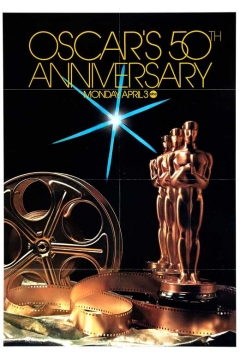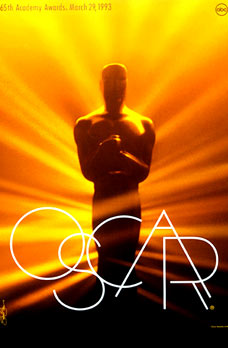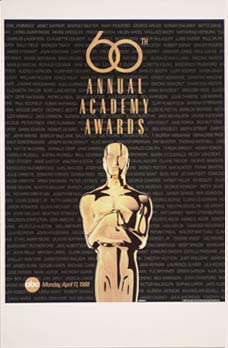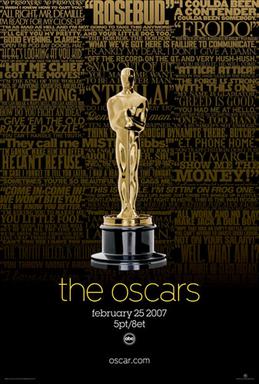
The Academy of Motion Picture Arts and Sciences (AMPAS), often pronounced AM-pass; also known as simply the Academy or the Motion Picture Academy) is a professional honorary organization in Beverly Hills, California, U.S., with the stated goal of advancing the arts and sciences of motion pictures. The Academy's corporate management and general policies are overseen by a board of governors, which includes representatives from each of the craft branches.

The Academy Award for Best Supporting Actress is an award presented annually by the Academy of Motion Picture Arts and Sciences (AMPAS). It has been awarded since the 9th Academy Awards to an actress who has delivered an outstanding performance in a supporting role in a film released that year. The award is traditionally presented by the previous year's Best Supporting Actor winner. In lieu of the traditional Oscar statuette, supporting acting recipients were given plaques up until the 16th Academy Awards, when statuettes were awarded to each category instead.

The Academy Award for Best Animated Feature is given each year for the best animated film. An animated feature is defined by the academy as a film with a running time of more than 40 minutes in which characters' performances are created using a frame-by-frame technique, a significant number of the major characters are animated, and animation figures in no less than 75 percent of the running time. The Academy Award for Best Animated Feature was first awarded in 2002 for films released in 2001.
The Academy Honorary Award – instituted in 1950 for the 23rd Academy Awards – is given annually by the Board of Governors of the Academy of Motion Picture Arts and Sciences (AMPAS). Since 2009, it has been presented at the separate annual Governors Awards rather than at the regular Academy Awards ceremony. The Honorary Award celebrates motion picture achievements that are not covered by existing Academy Awards, although prior winners of competitive Academy Awards are not excluded from receiving the award.
Margaret Florence Herrick, also known professionally as Margaret Gledhill, was an American librarian and the Executive Director of the Academy of Motion Picture Arts and Sciences. In 1971, the Academy's library was named the Margaret Herrick Library in her honor.

The 50th Academy Awards ceremony, presented by the Academy of Motion Picture Arts and Sciences (AMPAS), honored films released in 1977 and took place on April 3, 1978, at the Dorothy Chandler Pavilion in Los Angeles. During the ceremony, AMPAS presented Academy Awards in 22 categories. The ceremony, televised in the United States by ABC, was produced by Howard W. Koch and was directed by Marty Pasetta. Actor and comedian Bob Hope hosted the show for the 19th time. He first presided over the 12th ceremony held in 1940 and had last served as a co-host of the 47th ceremony held in 1975. Five days earlier, in a ceremony held at The Beverly Hilton in Beverly Hills, California, on March 29, the Academy Scientific and Technical Awards were presented by hosts Kirk Douglas and Gregory Peck.

The 65th Academy Awards ceremony, presented by the Academy of Motion Picture Arts and Sciences (AMPAS), honored films released in 1992 in the United States and took place on March 29, 1993, at the Dorothy Chandler Pavilion in Los Angeles beginning at 6:00 p.m. PST / 9:00 p.m. EST. During the ceremony, AMPAS presented Academy Awards in 23 categories. The ceremony, televised in the United States by ABC, was produced by Gil Cates and directed by Jeff Margolis. Actor Billy Crystal hosted the show for the fourth consecutive year. In related events, during a ceremony held at the Century Plaza Hotel in Los Angeles on March 6, the Academy Awards for Technical Achievement were presented by host Sharon Stone.

The 62nd Academy Awards ceremony, presented by the Academy of Motion Picture Arts and Sciences (AMPAS), honored the best films of 1989 and took place on March 26, 1990, at the Dorothy Chandler Pavilion in Los Angeles beginning at 6:00 p.m. PST / 9:00 p.m. EST. During the ceremony, AMPAS presented Academy Awards in 23 categories. The ceremony, televised in the United States by ABC, was produced by Gil Cates and directed by Jeff Margolis. Actor Billy Crystal hosted the show for the first time. Three weeks earlier in a ceremony held at The Beverly Hilton in Beverly Hills, California on March 3, the Academy Awards for Technical Achievement were presented by hosts Richard Dysart and Diane Ladd.

The 60th Academy Awards ceremony, presented by the Academy of Motion Picture Arts and Sciences (AMPAS), took place on April 11, 1988, at the Shrine Auditorium in Los Angeles beginning at 6:00 p.m. PDT. During the ceremony, AMPAS presented Academy Awards in 22 categories honoring films released in 1987. The ceremony, televised in the United States by ABC, was produced by Samuel Goldwyn Jr. and directed by Marty Pasetta. Actor Chevy Chase hosted the show for the second consecutive year. Two weeks earlier, in a ceremony held at the Beverly Hilton in Beverly Hills, California, on March 27, the Academy Awards for Technical Achievement were presented by host Shirley Jones.

The 79th Academy Awards ceremony, presented by the Academy of Motion Picture Arts and Sciences (AMPAS), honored the best films of 2006 and took place February 25, 2007, at the Kodak Theatre in Hollywood, Los Angeles beginning at 5:30 p.m. PST / 8:30 p.m. EST. During the ceremony, the Academy of Motion Picture Arts and Sciences presented Academy Awards in 24 categories. The ceremony, televised in the United States by ABC, was produced by Laura Ziskin and directed by Louis J. Horvitz. Actress Ellen DeGeneres hosted for the first time. Two weeks earlier in a ceremony at the Beverly Wilshire Hotel in Beverly Hills, California held on February 10, the Academy Awards for Technical Achievement were presented by host Maggie Gyllenhaal.

The 51st Academy Awards ceremony, organized by the Academy of Motion Picture Arts and Sciences (AMPAS), honored films released in 1978 and took place on April 9, 1979, at the Dorothy Chandler Pavilion in Los Angeles beginning at 7:00 p.m. PST / 10:00 p.m. EST. During the ceremony, AMPAS presented Academy Awards in 23 categories. The ceremony, televised in the United States by ABC, was produced by Jack Haley Jr. and directed by Marty Pasetta. Comedian and talk show host Johnny Carson hosted the show for the first time. Three days earlier in a ceremony held at The Beverly Hilton in Beverly Hills, California, the Academy Awards for Technical Achievement were presented by hosts Gregory Peck and Christopher Reeve.

The Pickford Center for Motion Picture Study is one of three Los Angeles-area facilities of the Academy of Motion Picture Arts and Sciences, located at 1313 Vine Street in central Hollywood. Precisely situated in the heart of Hollywood, the building site is endowed with terrific history of Hollywood. It is the oldest surviving structure in Hollywood that was designed specifically with television in mind. In addition to the 286-seat Linwood Dunn Theater, where numerous public events are presented throughout the year, the building houses several Academy departments, including the Academy Film Archive, the Science and Technology Council, and the Grants and Nicholl Fellowship programs.

The 82nd Academy Awards ceremony, presented by the Academy of Motion Picture Arts and Sciences (AMPAS), honored the best films of 2009 and took place on March 7, 2010, at the Kodak Theatre in Hollywood, Los Angeles beginning at 5:30 p.m. PST / 8:30 p.m. EST. The ceremony was scheduled after its usual late-February date to avoid conflicting with the 2010 Winter Olympics. During the ceremony, the Academy of Motion Picture Arts and Sciences presented Academy Awards in 24 categories. The ceremony was televised in the United States by ABC, and was produced by Bill Mechanic and Adam Shankman and directed by Hamish Hamilton. Actors Alec Baldwin and Steve Martin hosted the show. Martin hosted for the third time; he first presided over the 73rd ceremony held in 2001 and last hosted the 75th ceremony held in 2003. Meanwhile, this was Baldwin's first Oscars hosting stint. This was also the first telecast to have multiple hosts since the 59th ceremony held in 1987.

The Academy Award for Best Actor is an award presented annually by the Academy of Motion Picture Arts and Sciences (AMPAS). It has been awarded since the 1st Academy Awards to an actor who has delivered an outstanding performance in a leading role in a film released that year. The award is traditionally presented by the previous year's Best Actress winner.

The Academy Award for Best Actress is an award presented annually by the Academy of Motion Picture Arts and Sciences (AMPAS). It has been awarded since the 1st Academy Awards to an actress who has delivered an outstanding performance in a leading role in a film released that year. The award is traditionally presented by the previous year's Best Actor winner.
Robert Cushman was the photography curator for the Academy of Motion Picture Arts and Sciences (AMPAS) for 37 years. He is credited with developing and expanding the photographic archives of the Academy of Motion Picture Arts and Science's Margaret Herrick Library in Beverly Hills, California. The collection is estimated to consist of more than 10 million images and photographs as of 2009. Additional images were acquired by Cushman through his solicitation of donations from major Hollywood film studios, individuals and their families during his 37-year tenure with the Academy.

Douglas Elton Fairbanks Sr. was an American actor and filmmaker, best known for his swashbuckling roles in silent films. One of the biggest stars of the silent era, Fairbanks was referred to as "The King of Hollywood". He was also a founding member of United Artists as well as the Motion Picture Academy and hosted the 1st Academy Awards in 1929.















